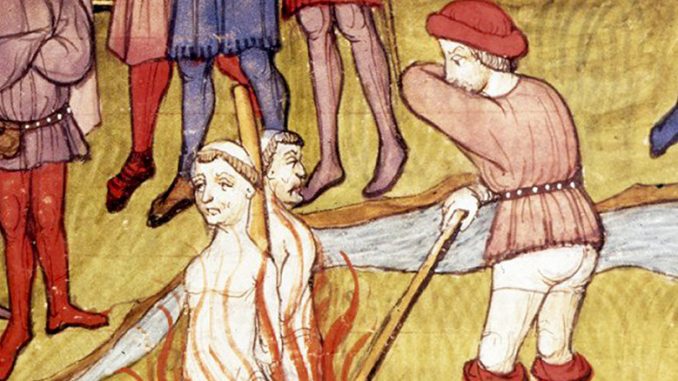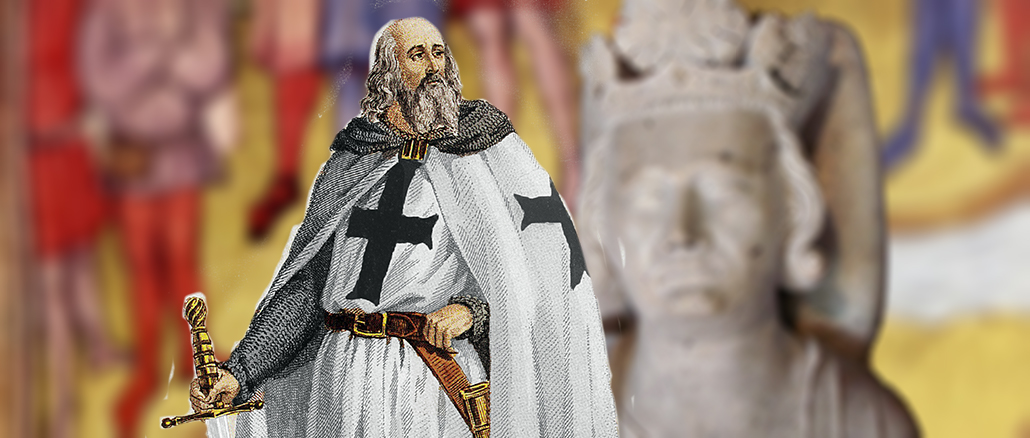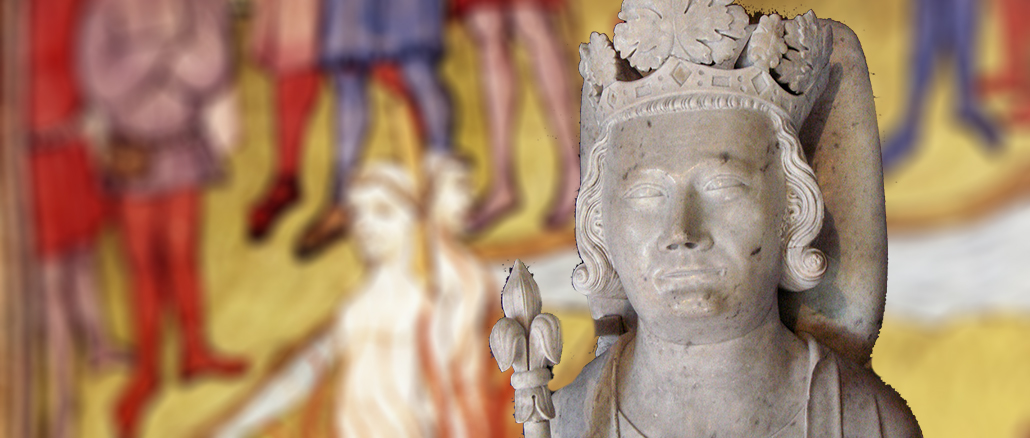
The following article on the downfall of the Templars was originally written for Knight Templar Magazine, the official publication of the Grand Encampment of Knights Templar (USA)
by Stephen Dafoe
The Brethren Persecuted: The Downfall of the Templars
Part One: The End Is The Beginning Is The End
On 28 May, 1291 the Templars relinquished their fortified compound to the Mamlukes who had been besieging the port city of Acre for the past six weeks. The Mamlukes had actually breached the city walls ten days earlier, but the Templars were the last to leave the field, a situation that was a long-standing tradition with the Order.
The loss of Acre was not merely another crusader defeat, for the port had been home to the Templars and Hospitallers for nearly a century; having been captured by Richard the Lionheart on 12 July, 1191. Although the capture of Acre marked the passing of the era of the Crusader States for Christendom, the Templars suffered as well. Not only had they lost their headquarters in the east, they also lost their grand master, William de Beaujeu, who was injured during the battle and died int he arms of a Hospitaller brother.
De Beaujeau was replaced by Theobald Gaudin, who was elected by his brethren at the Templar fortress at Sidon, 60 miles north of Acre. One of de Gaudin’s first actions as head of the Order was to remove himself to the Island of Cyprus to recruit assistance for his brethren. No help was to be received and on 12 July, the knights abandoned their last fortress on the mainland, joining their brethren on Cyprus.
When Pope Nicholas IV learned of the Christian defeat at Acre, he immediately made arrangements to take back the Holy Land. Part of his plan was to unite the military Orders into one cohesive unit. Of course the idea was not an original one, having been tossed around as early as 1274. Although Nicholas appointed a committee to investigate the idea, he died before their report was completed. A year later, Jacques de Molay, who had succeeded Gaudin as grand master, left the Island of Cyprus on a three-year tour of England, France, Aragon and Italy in the hopes of drumming up support for his own plan to recapture the Holy Land. De Molay wasn’t looking for fresh bodies to fight the enemies of Christendom, but to look for arms and aide for the cause. Pope Boniface VIII accommodated the Templars by issuing the Order a series of papal favours in 1297. The fact that the Holy Church was willing to continue its support of the Templars discredits the notion that after the loss of Acre, the Templars lost favour with the Holy See.
Although de Molay returned to Cyprus in 1296, the Templars did not involve themselves in many military campaigns; however, they seem to have become immersed in Cyprian political intrigue at the turn of the century, culminating in a change of Cyprian crowns in 1306.
De Molay and the pope
In the fall of that year, de Molay was once again on the move to France, having been summoned by Pope Clement V, who had resuscitated Nicholas’s idea of uniting the military Orders. It is at this point in the story where some popular Templar mythology needs to be debunked. Many modern works on the Templars make the claim that the real reason for Clement summoning de Molay to France was to lead him into a trap. This notion is apocryphally based on the unfortunate events that followed de Molay’s arrival. To understand the matter, we should understand a bit about Clement V and King Philip IV.
Philip became King of France at the age of 17, was the eleventh in a continuous line of male heirs to occupy the throne and, perhaps most importantly, was the grandson of a saint. But the Capetian Dynasty’s rich lineage had left young Philip with far more than big shoes to fill – massive war debt accumulated by his father’s battles in Aragon had left the country strapped for cash. Philip tried a variety of remedies – fiddling with the currency and even taxing the clergy, the latter of which created a long-standing riff between the king and Pope Boniface VIII. Philip’s remedy for that strife was to have the pope arrested; this was the same man who had proclaimed his grandfather King Louis IX a saint. It would be no surprise when Philip would turn on the Templars, who had helped bail his grandfather out of Egypt when he was captured during the crusades.
But while much of what has been written about Philip and the Templars is accurate, the story of Bertrand de Got – latterly known as Pope Clement V – is not. Although Bertrand and Philip had been childhood friends, their paths departed considerably in later life, de Got supporting Boniface VIII in his struggles with the French king. Many accounts of this period of Templar history have made the claim that Clement’s choosing to fulfil his papal duties from France rather than Rome was directly connected to the marionette strings of his king and master, Philip IV. This is certainly not the case. Clement was a Frenchman by birth and chose Avignon because political conflicts in Rome made Rome an unsafe place to do papal business. This was certainly nothing new, for Pope Urban II, who launched the First Crusade, had experienced similar problems during his rein, forcing his into exile for several years.
Uniting the Orders
From the safety of his Avignon throne, Clement V could focus part of his attention on the concept of uniting the crusading Orders into one all-powerful unit. In 1292, a man named Raymond Lull, who had written several treatises on recapturing the Holy Land, had put forth the idea of uniting the Orders under a Rex Bellator or war king. It was a position that Philip IV was willing to relinquish his monarchy to obtain, perhaps looking to live up the ideals of his crusading grandfather.
Although Philip, longing for the hot Levantine sun, may have loved the concept, de Molay, who had spent many years in the east, was less positive about the notion. In his report to Clement V, de Molay expressed his doubts on the grounds that the Templars and Hospitallers had existed separate for many years and the rivalry between the two Orders had benefited Christendom. Additionally, uniting the two Orders would require a new Rule of Order to be drafted. The Templar master feared that the less strict Hospitaller way of life would pollute that of the Templars.
With such important matters to Christendom being contemplated, it was understandable that the streets of Paris were rife with rumors. But they were not the only rumors involving the Templars – there was also the talk of heresy.
The Brethren Persecuted: The Downfall of the Templars
Part Two: Revenge Destroys Everything
They spit on the Holy Cross, these Knights Templar. Not only do they deny the divinity of Christ during their reception, they do not even worship God Almighty, but a graven idol instead.
These accusations, well known to many Templars, were the words of a renegade member of the Order named Esquin de Floryan, who – according to some accounts – had been imprisoned and subsequently made his claims known to his fellow inmates out of revenge. But sharing rumours with cellmates is of little benefit to a man longing for freedom. As such, de Floryan was eager to share the juicy gossip with Philip IV. The French King was not his first choice, for he had previously told the story to the King of Aragon, James II, who dismissed the rumours as the rubbish they were. Whether he actually believed the accusations, Philip was all too willing to make use of them to his full benefit, and immediately informed Clement V of all that had come before his ears.
Clement responded to Philip in a letter of 24 August, 1307 letting the king know that he was planning to launch a formal investigation into the accusations in October. Philip, of course, had no intention of letting the matter wait another two months and issued a letter to his bailiffs on 14 September, authorizing them to arrest the Templars 30 days later.
The Arrest of the Templars
On October 13, Philip’s men acted on the arrest orders, launching a series of raids on Templar properties throughout France. One of the more popular myths regarding this period of Templar history is that the Templars learned of the arrest orders early on and escaped in large number. The consensus among modern historians is that the Templars had little to no advance notice, although it is generally agreed that de Molay was aware of the rumours in circulation. Official records record twelve members of the Order who managed to escape and most of these were ultimately captured. Among them was Gérard de Villiers, the former Master of France and Imbert Blanke, the Master of Auvergne, who crossed over into England with a handful of brethren. Blanke was later captured and went on to play a role in defending the English Templars.
Regardless of just how many French Templars snuck away in the quiet of the night, no myth regarding their escape has gained more currency than the notion that the Templar fleet set sail from the French port of La Rochelle. According to the popular tale, the Templars loaded 18 galleys with men and treasure and pulled anchor, sailing for points unknown. The source of this myth comes from the testimony of Jean de Châlons, a serving brother, who said that he had heard that de Villiers had set sail with 18 galleys. De Châlons’s testimony regarding the Templar galleys was not based on first hand knowledge; rather it was merely a repeated rumour. Given that the rest of his testimony was damning of the Order, it is doubtful that there was any truth to his claims. The fact remains that the Templars simply did not have that sort of naval presence at the time. After the dissolution of the Templars in 1312, the Hospitallers became more involved in naval warfare as a result of their occupation of Rhodes; however, at that time they are recorded as having only four galleys. As such, the idea that the Templars had so large a fleet stretches credulity.
The Interrogation of the Templars
De Floryan had told Philip but a handful of lies about the Order, but by the time the French King had the Templars in custody, the laundry list of heresies had expanded to some 87 articles of accusation, including sodomy and the worship of a bearded head. In Paris, 138 members of the Order were put through a series of interrogations beginning on 19 October. Even in this Philip showed his cunning, as the depositions were to be sent to the king in sealed envelopes, but the details were to be widely circulated to help sway public opinion. Of course, it was equally important to make sure that the enclosures had just the right information. The Templars were kept isolated form one another and informed that both king and pope were aware of the scandalous activities of the Order; pardoned awaited the confessed, while certain death awaited the unrepentant. Of course, a little medieval torture was thrown in for good measure; for nothing will make a man say things that are untrue like the crack of a whip. It is hard to imagine how a group of knights who had remained on the field of battle despite incredible odds could cave to such measures, but it is important to remember that the majority of incarcerated Templars were not battle toughened warriors, but serving members of the Order. In all 36 Templars succumbed to the torments of their jailers and died before testifying.
On 27 November, Clement issued the bull Pastoralis praeminentiae, authorizing the arrest of the Templars throughout Christendom. The bull was not met with enthusiasm and even in countries that followed the papal orders, torture was not generally used and the arrests were with great reluctance.
Clement was not at all pleased with Philip’s handling of the matter and suspended the trial in February of 1308, demanding that it be handled by the Church. The pope capitulated to the king’s pressure and resumed the trials in July; however, he insisted that they remain under the Church’s control. In August, Clement issued another bull, Regnans in coelis, calling for a general council to be held at Vienne in October of 1310.
To prepare for the council, a new set of interrogations was commenced by the Church with a true desire to get to the bottom of the matter without the use of torture. Among the many interrogations were those conducted at the castle of Chinon in Tours, which have been made famous with the recent exaggerated claims about the discovery of the Chinon Parchment. In actual fact, the document is well known to historians, having been published in Étienne Baluze’s Lives of the Popes of Avignon in 1693. The papal commission who interviewed de Molay and other Templar leaders at Chinon absolved them from excommunication, but despite recent claims, did not find the Order innocent.
A call was sent out requesting those Templars who wished to defend the Order to assemble at Paris. By February 1310, 600 Templars came forth with a desire to testify, but in so doing they set up a catch-twenty-two for themselves with respect to Philip. Having previously confessed during the first set of interrogations, Philip argued that any subsequent recantations would mark them as lapsed heretics – an offence punishable by death.
On 12 May, 1310, fifty-four Templars were turned over to the king’s men and burned at the stake in Paris. They would not be the last.

The Brethren Persecuted: The Downfall of the Templars
Part Three: The Curse of Jacques de Molay
In August of 1308, Pope Clement V issued a papal bull calling for a general church council to be held at Vienne in October of 1310. The purpose of the council was to try the matter of the heinous charges levelled against the Templars by King Philip IV of France. However, the council was postponed a year – not out of any procrastination, but because the papal commission who had been given the task of collecting evidence was having difficulties. Witnesses and testimonies contracted one another or, in many cases, even themselves. When all was said and done, the commission determined that the Templars and their Rule of Order were orthodox, but that some peculiar and unworthy aspects had been allowed to creep into the Templar initiation ceremonies. Those who had acknowledged these errors were absolved of their sins and reinstated with the Church, as was the case at Chinon in Tours. It was this conclusion that was to be presented to the Council of Vienne, a matter that, had it been brought to full light, would have changed the face of Templar history.
But such was not to be the case. Although the church fathers who had gathered at the council were, for the most part, doubtful of the Orders’ guilt, King Philip had no intention of letting the matter go in the Order’s favor. On 20 March, 1312, Philip, along with a sizeable portion of his army arrived at Vienne. Within two days, Clement called a special meeting with his commissioners and a number of cardinals, who, in a four-fifths majority, voted to dissolve the Order of the Temple. The result was the papal bull Vox in Excelso, penned on 22 March and read publicly on 3 April. With so much evidence in support of the continuation – albeit modified – existence of the Templars, Clement knew that his report would be met with resistance. To this end, a clerk announced that anyone who rose to speak to the matter without permission would be excommunicated. Of course, with Philip sitting in the council chambers and his army sitting outside, there was little that could be done. After all, Clement did not wish to suffer the same fate as his predecessor Boniface VIII, in whose death, Philip had played a prominent role.
But even in the bull dissolving the Templars, a document of far greater important than the Chinon Parchment, we see that it was not the Order’s guilt, but reputation that was the cause.
“Therefore, with a sad heart, not by definitive sentence, but by apostolic provision or ordinance, we suppress, with the approval of the sacred council, the order of Templars, and its rule, habit and name, by an inviolable and perpetual decree, and we entirely forbid that anyone from now on enter the order, or receive or wear its habit, or presume to behave as a Templar.”
Of course, this was but the first of several papal bulls dealing with the dismantling of an Order that had served Christendom for nearly two centuries. A short time later, Clement issued the bull Ad Providam, which transferred Templar properties and assets to the Hospitallers, who were further authorized to pay the former Templars a pension. In the end, Philip had succeeded in destroying the Templars, but failed to acquire any of their assets for himself. But it would not be his last dealing with the now defunct Order or its members; for de Molay, the last Grand Master of the Templars, was still in prison.
The Death of de Molay
The story of Jacques de Molay’s final hours is an important one to Masonic Templars; for we see in his martyrdom a great act of resolve in the hour of danger, and a human parallel to the sufferings of Christ on the Cross. But de Molay’s execution, while a matter of historical record, has been greatly embellished over the years to include the notion that the last Grand Master cursed the king and pope, who died soon after. Although this story has formed the pinnacle of the Templar mythos for many years, early chroniclers mentioned de Molay’s execution in passing. The most reliable of the contemporary accounts comes to us from the continuation of the chronicles of Guillaume de Nangis. The writer tells us that on the Feast of St. Gregory (March 18) de Molay and other Templar leaders were brought to the steps of Notre Dame de Paris to hear the final decision of three cardinals, who had been charged with determining their fate. According to the chronicle, de Molay and Geoffrey de Charney – upon learning that they were to remain in prison for the rest of their lives – interrupted the cardinals in protest, retracting their pervious confessions. When Philip learned of the matter, he moved swiftly and ordered the same fate for the Templar leaders that he had issued to the fifty-four knights he’d burned at the stake in 1310. That evening de Molay and de Charney were taken to a little isle on the Seine and executed.
And this is where the curse myth begins, for the writer of the chronicle tells us that “They were seen to be so prepared to sustain the fire with easy mind and will that they brought from all those who saw them much admiration and surprise for the constancy of their death and final denial…” Beautiful and poetic words that should have been sufficient to solidify de Molay’s memory in the heart of all Templars; however, others would add to the story. In the popular tale, told in many Masonic templar settings over the years, de Molay did not suffer his fate with resolve and calm mind, but pronounced that before the end of the year Philip and Clement would meet him before God to answer for their crimes. While is certainly true that both men followed de Molay in death; Clement on April 20, as a result of his long suffered illness and Philip on November 29, after being thrown from a horse while hunting, it was not the curse that was responsible for the timing of their deaths, but the timing of their deaths that was responsible for the curse.
The closest contemporary source to the curse story comes from the words of Geoffrey de Paris, a clerk in Philip’s court who wrote in a poem that de Molay said God would avenge the Templars, for he knew who was truly in the wrong. It is not until 1330 that the curse legend begins to truly take form in the works of an Italian chronicler named Feretto de Ferretis, who puts the curse, not in de Molay’s mouth, but in the mouth of an anonymous Templar. Not until the sixteenth century, do we see the words actually ascribed to de Molay, when the French historian Paul Émile became the first to make the claim in his De rebus gestis francorum, published in 1548. Unfortunately, Émile was not the last and the myth of de Molay’s dying words has continued long after the Order he led has vanished into the pages of history and legend.
About Us
TemplarHistory.com was started in the fall of 1997 by Stephen Dafoe, a Canadian author who has written several books on the Templars and related subjects.
Read more from our Templar History Archives – Templar History




